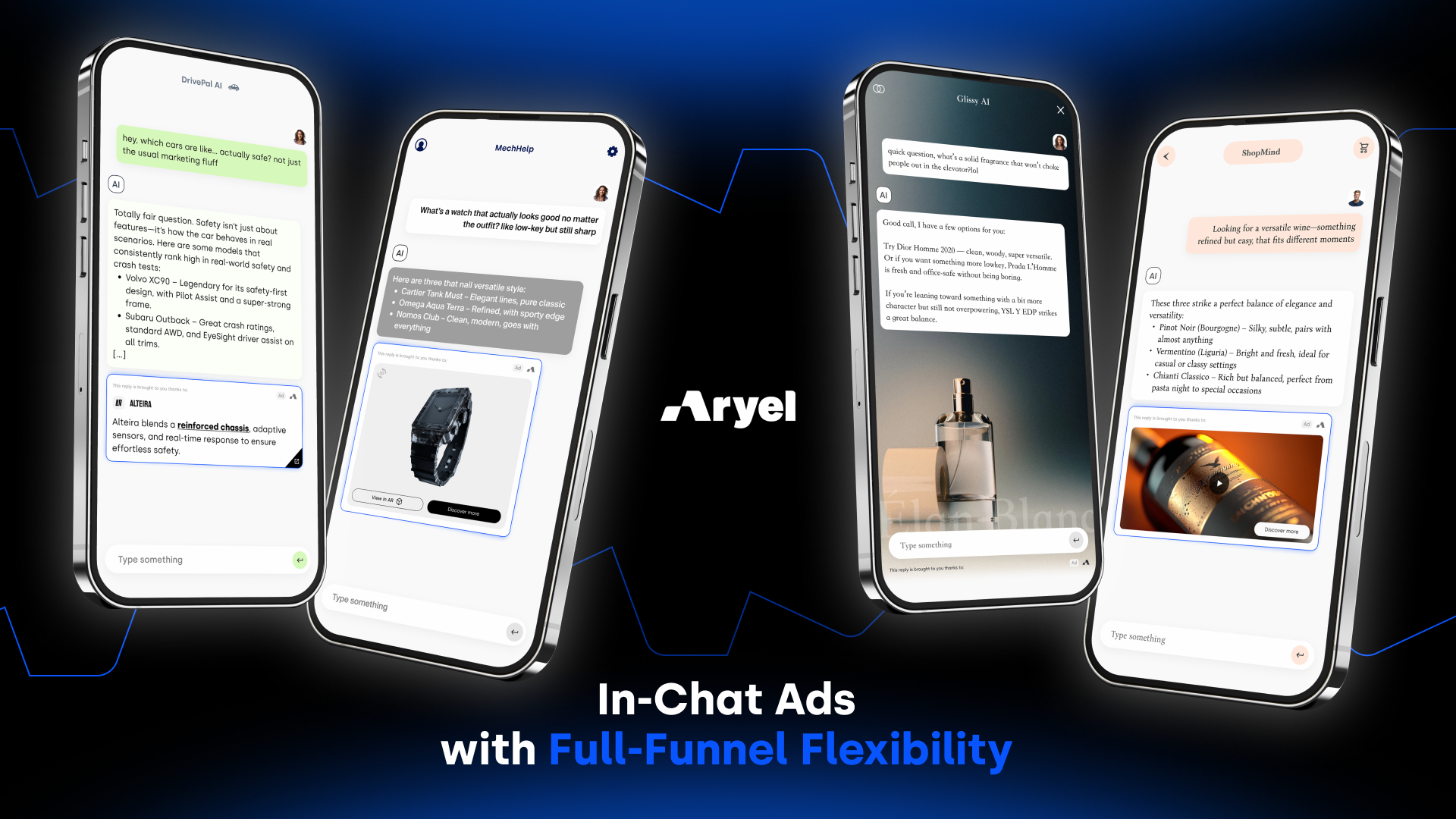Full-Funnel Ad formats for AI conversations: How In‑Chat Ads turn prompts into brand touchpoints

The way people search, discover and buy is changing, fast. More and more users are turning to conversational AI tools like ChatGPT and Claude to ask questions, evaluate products, and make decisions. That shift has opened up a brand new media space: the conversation itself.
At Aryel, we saw the opportunity. And we built a product to help brands show up right where users are already engaged.
Enter: In‑Chat Ads, the first ad format designed specifically for AI-powered conversations.
In‑Chat Ads are native, non-disruptive placements that appear alongside AI responses in large language model (LLM) chats. They’re triggered in real time by the user’s prompt, meaning they only show up when the conversation is actually relevant to your brand.
These ads don’t interrupt. They integrate. Seamlessly.
Unlike traditional search ads, In‑Chat Ads are:
The result? Ads that feel natural, helpful, and well-timed, because they are.
Let’s say a user asks “What kind of sunscreen should I use for sensitive skin?” or “Best running shoes under $100?” In‑Chat Ads let brands step in with relevant content that complements the AI’s answer, without hijacking the flow or pretending to be the assistant itself.
It’s your brand, right inside the conversation, positioned as a valuable addition rather than a distraction.
Everything happens in real-time, powered by Aryel’s semantic-predictive engine:
No delay. No guesswork. Just highly relevant, AI-native media.
Advertising inside AI chats isn’t just about being there, it’s about being relevant in the right moment, depending on what the user is trying to do. In‑Chat Ads aren’t a one-size-fits-all solution. They’re a full-funnel approach, designed to support the entire customer journey, from first spark to final action.
People turn to AI for different reasons: to explore, to compare, to decide. And with In‑Chat Ads, your brand can meet them in each of those moments, thanks to formats built with intent in mind.
At this stage, users are exploring ideas. They’re not looking to buy, yet, but they’re asking smart, category-relevant questions. It’s the perfect time to introduce your brand without interrupting the experience.
These appear when a user’s prompt is related to your industry, even if it isn’t purchase-driven. Imagine someone asking “What’s a good fragrance that’s office-friendly?” The AI gives a helpful answer, and just below it, your brand appears with a subtle tag: “This reply is brought to you by Élan Blanc.”
No push. No pitch. Just presence. It’s the ideal way to build brand recall early, in a moment of genuine user interest.
While the AI is generating its response, there’s a few seconds of wait time. Loader Ads turn that micro-moment into brand time, displaying short, branded video content during the “thinking” phase.
It doesn’t feel like an ad. It feels like something is happening while you wait. The result? Higher attention, stronger recall, and zero interruption.
Now the user is getting more specific. They’re comparing, asking for recommendations, exploring their options. This is where deeper engagement matters, and where rich media really performs.
These autoplay, muted videos appear directly inside the conversation when the moment is right. A user might ask for wine suggestions for a dinner party, and right below the AI’s response, your video plays: golden light on a bottle, slow pan, subtle branding.
It’s simple, sensory, and timed for impact, letting you tell a richer story when the user is leaning in.
When users are actively evaluating, Immersive Ads step in. Think product carousels or swipeable galleries, embedded inside the chat, fully interactive, and built for exploration.
For example: a user asks about the best sneakers for summer, and the AI responds. Just below, a scrollable set of your latest models appears, lightweight, dynamic, and ready to shop.
These ads don’t just inform, they invite discovery.
At this point, intent is crystal clear. The user knows what they’re looking for, and they’re close to making a decision. That’s when the ad has to be smart, helpful, and hyper-relevant.
These are contextual prompts that appear after the AI’s answer, designed to guide action without forcing it. Picture someone asking, “Which cars are actually safe?” The AI offers its breakdown, then your ad appears right after: “Explore the new Alteria with reinforced chassis and adaptive sensors.”
It feels like a continuation of the conversation, not an ad break. And it works.
In‑Chat Ads don’t stop at the conversation. By leveraging contextual signals and anonymized engagement patterns, brands can extend the user journey with retargeting across the open web. This allows for consistent messaging beyond the chat window, re-engaging high-intent users with tailored creatives that reflect the questions they asked and the products they considered.
It’s a seamless way to bridge in-chat engagement with broader performance strategies.
In‑Chat Ads weren’t designed to disrupt. They were built to integrate: gently, intelligently, and where it counts.
While people are turning to AI to get answers, make choices, and discover what’s next, your brand can now be part of that process. Naturally. Natively. Respectfully.
Whether it’s planting a seed at the awareness stage, inspiring with immersive stories mid-journey, or offering the right nudge at the moment of decision. In‑Chat Ads let you be there, without breaking the flow.
It’s not about rethinking advertising. It’s about repositioning it, inside what’s already happening.